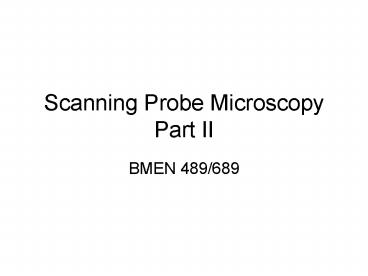Scanning Probe Microscopy Part II - PowerPoint PPT Presentation
1 / 16
Title:
Scanning Probe Microscopy Part II
Description:
AFM can work well in liquid samples, so it is well suited to biological studies ... Dept. of Zoology and Genetics, Iowa State University, Ames, IA 50011. NSOM Images ... – PowerPoint PPT presentation
Number of Views:62
Avg rating:3.0/5.0
Title: Scanning Probe Microscopy Part II
1
Scanning Probe MicroscopyPart II
- BMEN 489/689
2
AFM in Biological Samples
- AFM can work well in liquid samples, so it is
well suited to biological studies - Electrolytes in the media and pH must be
considered because they can alter the
probe/material interaction - Silicon/silicon nitride will degrade in water
environment - Probe tips can become negatively charged and skew
the experimental results
3
AFM in Biological Samples
- Even with minimal tracking forces, contact mode
can damage or distort biological samples.
Additionally, adsorbed gas at surface pulls the
probe toward the sample. - Non-contact mode provides low resolution in
liquid as the attractive force is weak and can be
further screened by surface contaminants - Tapping mode allows measurement of samples that
are easily damaged or loosely held to surface.
High frequency makes surface stiff (viscoelastic)
greatly reducing the tip/sample adhesion forces
(non-stick)
4
AFM in Biological Samples
- AFM imaging of biological samples offers
significant advantages compared to other
techniques such as electron microscopy - Little or no sample preparation
- Imaging occurs under near native conditions
- Media exchange/modification allows imaging of
specific interactions - However, AFM does not yield molecular resolution
5
AFM in Biol Probes
- Often the AFM probe tips are functionalized to
preserve them (hydrophobic coating) or allow
attachment of bio-molecules - Biotinylated
- PEG with amine or carboxyl
- Oligonucleotides for RNA/DNA
- Cells (grown on beads)
- The cantilevers resonance freq is much lower in
water - Viscous damping
- Need to move fluid greater effective mass
6
AFM in Biol Applications
- AFM micrographs of DNA on a surface. AFM opened
the door for imaging DNA in aqueous environments.
Tapping mode allows such images with minimal
sample damage
Angel Rivera, Department of Microbiology,
University of Illinois at Urbana-Champaign
7
AFM in Biol Applications
- AFM image of aggregated Protein (ß2M) Fibril
implicated which has been implicated in diseases
like Alzheimer's and Parkinson's
Note periodicity of spiral pattern (left-handed)
Scale bar is 200nm
http//www.astbury.leeds.ac.uk/Facil/SPM/SPM.htm
8
AFM in Biol Applications
- Researchers also take advantage AFMs ability to
apply/control small forces (pN scale)
9
Near-field Scanning Optical Microscopy (NSOM or
SNOM)
- Using near-field light presents the opportunity
to perform spectroscopy below the diffraction
limit (resmin 0.61 ?) - Near-field refers to the fact that the light is
put through a subwavelength aperture - The emerging light contains a large fraction of
non-propagating, evanescent field - the decays exponentially away
- from the aperture
- ( aperture/p)
10
NSOM Probes
- In reality, optical fibers are used as the probe
- These are normally designed to propagate light
and have core diameters of gt5µm - The fiber is heated and pulled down until it
breaks (50nm in diameter) - The taper is coated with metal to prevent light
loss
www.monos.leidenuniv.nl/smo/index.html?basics/micr
oscopy.htm
physics.nist.gov/Divisions/Div844/facilities/nsom/
nsom.html
11
NSOM Probes
- The fiber is then attached to a tuning fork
- The system has a resonant frequency and
interactions between the tip and the surface are
sensed through atomic interactions - Distance from surface 5-50nm
www.olympusmicro.com/primer/techniques/nearfield/n
earfieldintro.html
www.azonano.com
12
NSOM Detection
- There are four standard modes of operation
- Transmission incident light through NSOM
detected through sample with standard optics - Reflection incident light through NSOM detect
light from sample surface - Collection illuminate sample with standard
optics and collect with NSOM - Illumination/collection NSOM used for
illumination and collection
www.nanonics.co.il
www.olympusmicro.com/primer/techniques/nearfield
13
NSOM Images
- Here is an image of aluminum bumps on a slide.
Note the topographic image and the NSOM image are
correlated
Topographic Image
NSOM Image
electron.mit.edu/gsteele/mirrors/elchem.kaist.ac.
kr/jhkwak/TopometrixWeb/lumstd.htm
14
NSOM Images
- Images of muscle tissue showing the ability to
image tissue in culture
Sid Ragona and Phil Haydon, Laboratory of
Cellular Signaling Dept. of Zoology and Genetics,
Iowa State University, Ames, IA 50011
15
NSOM Images
- Epi-illumination and near-field image of cell
loaded with Fluo-3 (Ca2 indicator). Note the
single molecule imaging in NSOM
Sid Ragona and Phil Haydon, Laboratory of
Cellular Signaling Dept. of Zoology and Genetics,
Iowa State University, Ames, IA 50011
16
NSOM Images
- Can also combine the technique with SERS to see
individual R6-G molecules

